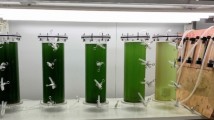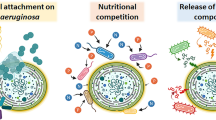Abstract
Affordable biological technology for the reclamation of wastes and water of the waste streams from intensive livestock units is important in a country short of water. This study tested the concept of reclamation of waste by Streptocephalus macrourus (Crustacea: Anostraca) from the effluent of a high rate algal pond processing livestock wastes. S. macrourus showed a growth efficiency of 39% to 74% when fed optimal rations and cultured at densities between 10 and 400 1−1. The maximum daily growth rates (0.15–0.21) approximate the growth rates of cladoceran or rotifer cultures managed for maximal biomass production. S. macrourus' ability to withstand crowding enabled the production from S. macrourus cultures (up to 91.8 mg dry mass l−1 d−1, or 1241 mg wet mass l−1 d−1) to exceed production recorded from cladoceran or rotifer cultures. Temperature influenced growth rate, with the highest growth rate occurring at 24 °C. The dilution rate of continuously fed cultures influenced growth rate, with the optimum dilution rate tested being 10 ml organism −1 d−1. Mass mortality occurred when organisms were held at a density of 4000 l−1. S. macrourus is able to convert algae grown on livestock waste efficiently into anostracan biomass, and is able to give a very high daily production.
Similar content being viewed by others
References
Boraas, M. E., 1983. Population dynamics of food limited rotifers in two stage chemostat culture. Limnol. Oceanogr. 27: 546–563.
Carpenter, R. L., 1978. Aquaculture as an alternative waste water treatment. In Pastakia C. M. R. (ed.), Fish farming and wastes. Report of the proceedings of an international conference held at the University College of London, 4–5 January 1978. London: 110–115.
Caulton, M. S., 1982. Feeding, metabolism and growth of tilapias: some quantitative considerations. In Pullin R. S. V. & R. H. Lowe-McConnell (eds), The biology and culture of tilapias. ICLARM. Manila, Phillipines: 157–183.
Dinges, R., 1982. Natural systems for water pollution control. van Nostrand Reinhold Environmental Engineering Series. New York. 252 pp.
Funke, J. W., J. G. Knoesen & J. C. Venter, 1984. Code of practice for the handling of manure from intensive animal feeding units. Water Research Commission, Pretoria. 42 pp.
Gaigher, I. G. & J. B. Krause, 1983. Growth rates of mosambique tilapia (Oreochromis mossambicus) and silver carp (Hypophthalmichthys molitrix) without artificial feeding in floating cages in plankton-rich waste water. Aquaculture 31: 361–367.
Gallagher, M. & W. D. Brown, 1975. Composition of San Francisco Bay brine shrimp (Artemia salina). J. agric. Food. Chem. 23: 630–632
Groeneweg, J. & M. Schluter, 1981. Mass production of freshwater rotifers on liquid wastes. II. Mass production of Brachionus rubens Ehrenberg in 1838 in the effluent of high rate algal ponds used for the treatment of piggery waste. Aquaculture 25: 25–33.
Hirata, H., 1979. Rotifer culture in Japan. In Styczynska-Jurewicz E., T. Backiel, E. Jaspers & G. Persoone (eds). Cultivation of fish fry and its love food. European Mariculture Society special publication No. 4. Bredene, Belgium: 361–376.
Ivleva, I. V., 1973. Mass cultivation of invertebrates, biology and methods. Israel program for scientific translations. Jerusalem. 148 pp.
James, C. M., M. Bou-Abbas, A. M. Al-Khars, S. Al-Hinty & A. E. Salman, 1983. Production of the rotifer Brachionus plicatilis for aquaculture in Kuwait. Hydrobiologia 104: 77–84
Lei, C-H. & K. B. Armitage, 1980. Ecological energetics of a Daphnia ambigua population. Hydrobiologia 70: 133–143.
Lincoln, E. P., B. Koopman, L. O. Bagnall & R. A. Nordstedt, 1986. Aquatic system for food and feed production from livestock wastes. J. Agric. Engng. Res. 33: 159–169.
Milligan, D. J., J. A. Quick, S. E. Hill, J. A. Morris & R. J. Hover, 1980. Sequential use of bacteria, algae and brine shrimp to treat industrial waste water at pilot plant scale. In Persoone G., P. Sorgeloos, O. Roels & E. Jaspers (eds), The Brine Shrimp Artemia Vol. 3. Universa Press, Wetteren, Belgium: 193–206.
Mitchell, S. A., 1986. Experiences with outdoor semi-continuous mass culture of Brachionus calyciflorus Pallas (Rotifera). Aquaculture 51: 289–297.
Mitchell, S. A. & A. Richmond, 1987. The use of rotifers for the maintenance of monoalgal mass cultures of Spirulina. Biotechn. Bioeng. 30: 164–168.
Pirt, J. S., 1975. Principles of cell and microbe cultivation. Blackwell Scientific Publications. Oxford.
Proulx, D. & J. de la Noue, 1985. Harvesting Daphnia magnum grown on urban tertiarily-treated effluents. Wat. Res. 19: 1319–1324.
Reeve, M. R., 1963. Growth efficiency in Artemia under laboratory conditions. Biol. Bull. 125: 133–145.
Schluter, M. & J. Groeneweg, 1981. Mass production of freshwater rotifers on liquid wastes. I. The influence of some environmental factors on population growth of Brachionus rubens Ehrenberg 1838. Aquaculture 25: 17–24.
Tarifeno-Silva, E., L. Y. Kawasaki, D. P. Yu, M. S. Gordon & D. J. Chapman, 1982. Aquacultural approaches to recycling of dissolved nutrients in secondarily treated domestic wastewaters. II. Biological productivity of artificial foodchains. Wat. Res. 16: 51–57.
Walmsley, R. D. & S. N. Shillinglaw, 1984. Mass algal culture in outdoor plastic-covered minipond systems. Ann. appl. Biol. 104: 185–197.
Williams, W. D., 1985. Biotic adaptations in temporary lentic waters, with special reference to those in arid and semiarid regions. Hydrobiologia 125: 85–110.
Author information
Authors and Affiliations
Rights and permissions
About this article
Cite this article
Mitchell, S.A. The growth rate and growth efficiency of Streptocephalus macrourus (Crustacea, Anostraca) cultured on microalgae. Hydrobiologia 212, 1–10 (1991). https://doi.org/10.1007/BF00025980
Issue Date:
DOI: https://doi.org/10.1007/BF00025980




